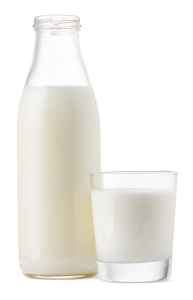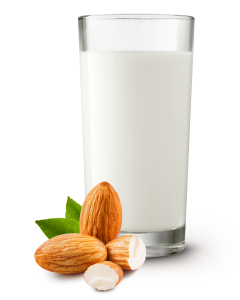There are many types of milk you can buy at the supermarket, which has seemingly increased by tenfold in the last decade or so. Now instead of just full cream and low-fat milk, you can find all kinds of milk from not just cows but other alternatives. Canstar Blue has put together a simple guide to help you decipher which kinds of milk are which and potentially which one you may want to drink.
Types of milk
There’s plenty of options available if you’re after some milk, including:
- Full cream milk
- Reduced-fat and low-fat milk
- Skim milk
- Long-life milk
- Soy milk
- Nut milk
- Seed-based milk
- Goat milk
Full cream milk

Full cream, or whole milk, is defined as milk with a fat percentage of somewhere between 3.25% and 3.5%. It’s more or less the closest you can get to drinking milk the way it comes from the cow before being processed. While it will be pasteurised and (probably) homogenised, it has the same ratio of fat to milk as raw milk. Whole milk has the highest number of calories and saturated fat of any type of milk, along with more cholesterol.
Reduced-fat milk and low-fat milk
While the terms ‘reduced-fat’ and ‘low-fat’ seem interchangeable, when it comes to milk, they actually have separate and distinct meanings. Reduced fat milk is milk with a fat percentage of 2%, whereas low fat milk is milk with a fat percentage of 1%. While these milks have less calories and saturated fat, they also have less nutritional value, as fat-soluble vitamins D, A, E, and K end up being mostly removed with the fat. However, some companies have found ways to add the lost vitamins back in to ensure their milk is still nutritionally strong.
Skim milk
Also known as skimmed milk, skim milk is milk with zero fat. Because of its lack of fat, it’s generally thinner than other milks, which some companies combat by adding powdered milk, which can contain carcinogens such as oxidised cholesterol. Not all skim milk contains additives, so be sure to check the label and list of ingredients to ensure that you know what you’re buying.
Long-life milk
Also known as UHT (ultra-high temperature) milk, long-life milk is milk that is pasteurised at a much higher temperature than regular milk. Specifically, the milk is heated to above 135°C for 1-2 seconds, as opposed to regular milk which is heated to just over 70°C for 15 seconds. The way UHT milk is pasteurised gives it an unrefrigerated shelf life of six to nine months, hence the name. Unless specified otherwise on the label, UHT milk is very similar to whole milk in terms of nutrition and fat content.
Soy milk
Probably the most well-known dairy alternative, soy milk is made from soybeans that have been soaked in water and then ground up. Soy milk is a complete protein, and has roughly the same amount of protein as whole milk. However, it’s less useful in the way of calcium, as the calcium found in soybeans is indigestible by humans. That being said, many soy milks are fortified with calcium during production and have very little saturated fat and no cholesterol.
Nut milks and seed-based milks

If you’re looking for a dairy-free alternative to milk but don’t particularly fancy soy milk, there’s always nut and seed-based milks. Almond milk in particular is widely available in supermarkets, but dairy alternatives can also easily be made from cashews and flaxseed. These dairy alternatives are free of cholesterol and saturated fats, containing only healthy, monounsaturated fats, and can be lower in calories and higher in Riboflavin (also known as vitamin B2).
Other popular milk alternatives include oat milk, coconut milk, rice milk and macadamia milk. Each of these types of milk alternatives offer their own set of nutritional benefits based on the type of nut or seed used to make the milk.
Goat milk
The name’s rather self-explanatory for this one, but how does it stack up against cow’s milk? Well to start off, it’s higher in calories and fat, including saturated fat. However, it’s lower in sugar, much higher in calcium and magnesium, and contains 5% of your daily vitamin C. It also has slightly more protein, much more potassium, and more vitamin A. Cow’s milk has the upper hand when it comes to vitamin B12 and folate, and both have similar amounts of cholesterol and vitamin D. However, cow’s milk comes out on top when it comes to selenium and B12, making choosing between the two harder than you might have thought. However, this type of milk isn’t as widely available as other milk types, so you may have to look a bit harder if you enjoy it.
What are the best brands of milk?
While which type of milk you enjoy is subjective, there are particular brands of milk that have been highly rated by consumers. Based on Canstar Blue’s Most Satisfied Customer award for 2022, below are the best rated brands of milk for full cream, long-life, reduced-fat and skim milk.
Best rated full cream and long-life milk – Aldi Farmdale
Aldi is best known for their cheaper groceries that put their discount spin on a number of popular products. Its Farmdale full cream milk was rated the best for overall satisfaction from customers, and considering it generally retails at only $2.39 for full cream and $1.59 for long-life milk, it’s clear why it’s a favourite from a price point of view. Aldi’s Farmdale brand also offers a variety of other dairy products like sour cream, yoghurt and thickened cream.
Best rated reduced-fat and skim milk – Woolworths
Skim milk isn’t necessarily a first choice for everyone, but for those who want a lighter alternative Woolworths’ reduced-fat and skim milk was a crowd favourite. Rated five stars for overall satisfaction, it generally costs between $1.60 and $4.50 from 1L to 3L. Woolworths additionally offer a lactose-free version for those a little sensitive to dairy.
Advertisement
Which type of milk should I buy?
At the end of the day there’s a whole lot of different milks and milk alternatives, so whether you want to stick with your whole milk or try something more adventurous like flaxseed milk, you really can’t go wrong with whatever you end up choosing. If you have any doubts about the kind of milk you should be drinking for your own personal dietary requirements, make sure you talk to a health professional, such as a nutritionist or your GP, as while you may enjoy one type of milk, your body may prefer another.
Original Author: James Hurwood


Share this article